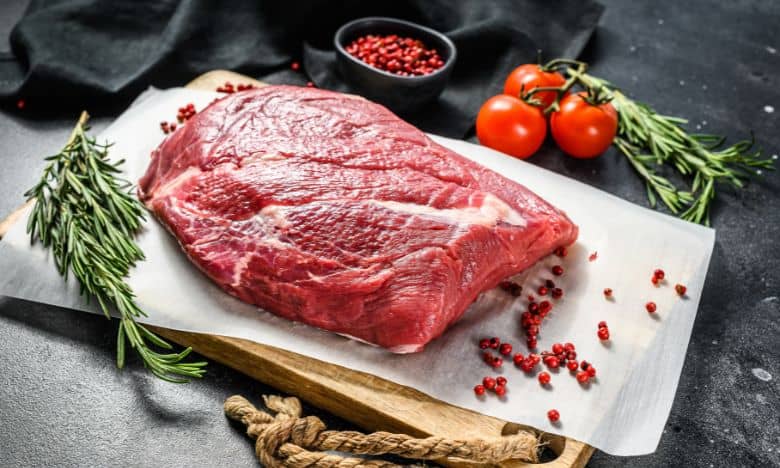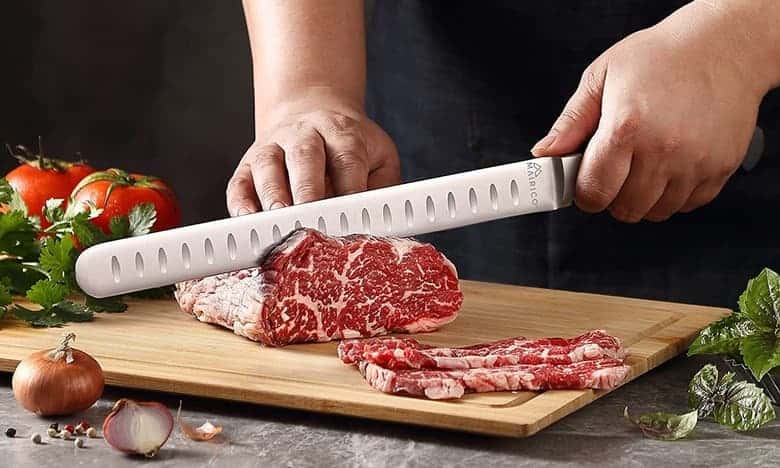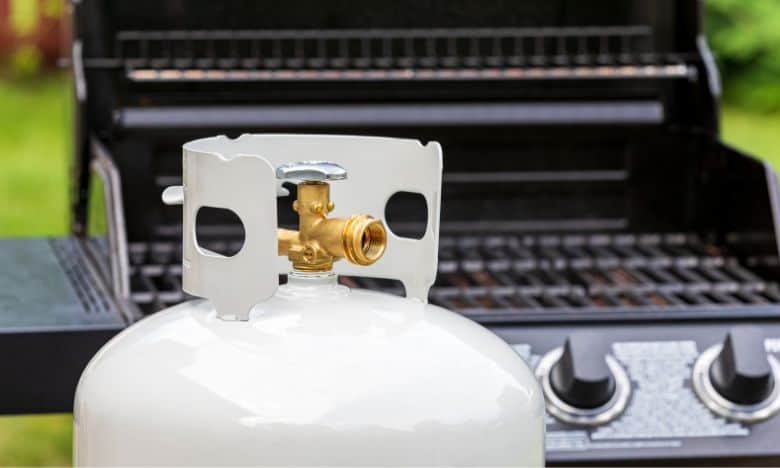Learn how to sharpen a brisket knife with our comprehensive guide. Understand the difference between honing and sharpening, find out when your knife needs attention, and explore the step-by-step process to achieve a razor-sharp blade.
A sharp blade is to a BBQ master what a magic wand is to a wizard. In the world of barbecue, few tasks are as essential as slicing brisket. This job requires a sharp brisket knife. As such, sharpening your brisket knife should be part of your kitchen routine!
In this guide, we’ll explore how to sharpen knives, particularly your brisket knife, to help you carve thin slices of meat like a pro. Whether you’re working with smoked brisket, ham, or rib eye roast, a sharp knife will help you achieve precision slices every time.
Table of Contents
Understanding Your Brisket Knife
A kitchen is only as efficient as its tools, and when it comes to barbecue, a brisket knife holds a place of honor. No chef knife or kitchen knife can replicate the precision and control a brisket knife provides. Engineered to be a workhorse in the kitchen, a brisket knife is a key component in preparing perfectly smoked brisket or any large cuts of meat.
Mercer Culinary 14-Inch Slicer Granton Edge Knife
- Comfortable ergonomic handle and textured grip
- Made of high-carbon steel
- Razor-sharp edge
So whether you’re a seasoned pitmaster or a novice home cook, understanding your brisket knife is vital for optimal performance and a triumphant barbecue feast.
Anatomy of a Brisket Knife
A brisket knife, sometimes referred to as a slicing knife or carving knife, features a long, straight blade designed for slicing large cuts of meat. The flat side of the blade helps produce perfect thin slices, while the ergonomic handle shape offers better control and durability.
Unlike chef knives or serrated knives used for various kitchen tasks, a brisket slicer is purpose-built for tackling large, cooked meats. Its size can handle the length and breadth of a sizeable brisket and its thin blade ensures that every slice maintains its shape and texture.
Selecting the Right Brisket Knife
Choosing the right brisket knife is an art in itself. Look for a slicing knife with a sharp edge that can handle the hardness of meat. Also, consider the knife’s material (stainless steel is a good option), weight, and durability. Some manufacturers engineer their knives with features like a diamond edge for superior sharpness.
Just like any of your kitchen knives, the material of the brisket knife is crucial for its longevity and performance. Stainless steel, recognized for its hardness and durability, is often the preferred choice. These blades retain their sharpness for longer and can withstand the rigors of frequent use.
However, remember that even the most robust blade can become dull over time. Regular maintenance, including both sharpening and honing, ensures that your brisket knife is always ready for action. These processes are not merely tips for a better barbecue but essential steps for achieving the ultimate aim: thin, even slices of beautifully smoked brisket that speak of your prowess behind the grill.
The Sharpening Process
To sharpen your brisket knife, you’ll need a few sharpening tools. Knife sharpeners are essential, but honing tools such as honing steel or even electric sharpeners can also be useful.
Before you start sharpening, clean your knife to remove any meat residue or other materials. This will ensure you have a clear, clean blade to work with.
Step-by-Step Guide to Sharpening Your Brisket Knife
- Place your knife sharpener on a flat, stable surface.
- Position the blade in the sharpener’s slot, ensuring the sharp edge is facing down.
- Pull the knife towards you five times with pressure and five times without pressure.
- Test the sharpness of your knife by slicing a piece of paper or a tomato. If it slices effortlessly, your knife is sharp.
Honing Your Brisket Knife
Once your knife is sharp, it’s time to hone it. Honing realigns the edge of the knife, making it straighter and sharper. Use your honing steel for this process:
Professional Carbon Steel Knife Sharpening Steel
- 12″ Sharpening Steel
- made of carbon steel and plated with nickel-chrome
- Ergonomic, easy-to-grip polypropylene handle with hanging hole
- If you are not experienced at using a honing steel, it’s best to place the tip on a folded tea towel or damp dishcloth for extra stability. Experienced users can hold the steel in mid-air.
- Hold the blade at a 20° angle to the honing steel.
- Pull the knife downwards and towards you, moving from the heel to the tip of the blade.
- Repeat five times on each side of the blade.
After Sharpening: Maintenance and Care
Once your brisket knife is as sharp as it needs to be, the journey to maintaining its sharp edge has only just begun. Proper care and maintenance not only ensure a longer life for your knife but also guarantee a safer and more efficient kitchen experience.
How to Store Your Knife
Storing your knife properly is key to maintaining its sharp edge. A knife block, magnetic strip, or individual blade guard can help protect your knife from becoming dull.
The right storage can keep your knife away from hard surfaces or other utensils that might chip or dull its edge. It also reduces the risk of accidental cuts when reaching into a drawer.
- Knife Block: A knife block provides a dedicated slot for each of your knives, reducing the chance of the blades rubbing against each other. It also keeps the sharp edge protected from potential damage.
- Magnetic Strip: This option allows you to store your knives on the wall, adding a decorative touch to your kitchen while also preserving the blade’s edge.
- Individual Blade Guard: Blade guards are great for those who have limited kitchen space or who travel with their knives. They protect the blade from getting nicked or dulled when stored in a drawer or a bag.
Regular Maintenance
Sharpening your knife should be a regular task. For normal home cooking, we recommend you sharpen your knife after every 30-40 uses, or even before every new culinary project for professional chefs. Frequent honing can keep your knife’s edge perfectly aligned and ready for precise slicing.
However, with years of use and resharpening, the cutting edge of a knife blade will become thicker, making the resharpening process more difficult. In this case, consider a professional sharpening service. Professionals use advanced tools and techniques to restore the sharpness of your knife without causing undue wear on the blade.
Safety Tips
Sharpened knives require responsible handling. Here are some safety tips for working with a sharp brisket knife:
- Always Cut Away from Your Body: When slicing meat, always ensure the blade’s edge is facing away from you. This reduces the risk of accidentally cutting yourself.
- Keep Your Knife Clean: Meat residues can make the knife handle slippery. Always clean your knife after use to prevent it from slipping out of your hands.
- Use a Cutting Board: A cutting board provides a stable surface for your knife. Avoid cutting on plates or other hard surfaces that can dull the blade.
- Don’t Leave Knives in the Sink: Leaving knives in the sink can lead to accidental cuts when reaching in. Always clean and dry your knives immediately after use.
- Handle with Care: Even when not in use, handle your knife with care. Always pick up a knife by its handle and never attempt to catch a falling knife.
By following these guidelines, you’ll ensure your brisket knife stays sharp and safe for a long time, ready to help you create culinary masterpieces at every barbecue.
Putting Your Sharp Knife to Work
When slicing brisket, the goal is to achieve thin, uniform slices that maximize tenderness and flavor. Let’s put our sharpened blades to work and explore the best practices in brisket slicing.
Understanding the Structure of Your Brisket
Brisket comes from the lower chest or breast of the cow and is composed of two different muscles: the flat and the point. These muscles have grains or muscle fibers running in different directions, which is crucial when it comes to slicing.

The flat is the leaner part of the brisket with straight, easy-to-identify grain lines. The point, on the other hand, is the fattier part that gives the melt-in-your-mouth BBQ experience we all love. Its grain lines may run differently than those of the flat.
The Step-by-Step Guide to Perfect Brisket Slicing
- Prepare Your Brisket: Once your brisket has rested post-cooking, place it on a large cutting board with the fat cap facing upwards. This position aids in preserving the meat’s juiciness as you slice.
- Identify the Grain Direction: Determine the direction of the grain, or the alignment of the muscle fibers. The key to tender slices lies in cutting against the grain, which shortens the muscle fibers and results in an easier chew.
- Cut the Flat: Position your knife perpendicular to the grain and begin slicing, targeting a thickness of about a quarter-inch. Remember to apply gentle, smooth strokes. Sawing back and forth could tear the meat and spoil the texture.
- Transition to the Point: When you reach the area where the flat meets the point, rotate the brisket 90 degrees. This change is due to the differing grain directions in the two sections of the brisket.
- Cut the Point: Continue slicing against the grain in the point section of the brisket. These slices will be fattier and packed with flavor, perfect for those who love a robust, beefy bite.
By mastering the art of brisket slicing, you can maximize the flavor and tenderness of this BBQ classic. A well-sharpened knife and a keen understanding of brisket anatomy are your best tools for turning a well-smoked brisket into a memorable feast.
Brisket Sharpening FAQs
What angle do you sharpen a brisket knife?
Brisket knives, like most kitchen knives, should generally be sharpened at an angle of 15-20 degrees. Maintaining this angle will provide a balance of sharpness and durability for the knife’s edge.
What do you use to sharpen a butcher knife?
Butcher knives can be sharpened using a variety of tools. Whetstones are often used due to their control and effectiveness. Manual or electric knife sharpeners are also viable options, especially those designed to sharpen at the correct angle.
Why are brisket knives rounded?
Some brisket knives are rounded at the tip to add flexibility and maneuverability, making it easier to slice through large pieces of meat like brisket. This shape also helps to reduce the chances of the knife poking or tearing the meat, which would compromise the texture and presentation of the sliced brisket.
Should I heat a knife before sharpening it?
No, you should not heat a knife before sharpening. Heating can alter the temper of the blade, potentially making it softer and less capable of maintaining a sharp edge.
Do knives get too old to sharpen?
Knives do not inherently become too old to sharpen. However, with time and repeated sharpening, the blade can wear down or become damaged, making effective sharpening more difficult. In these cases, it may be time to consider a replacement.
How many swipes does it take to sharpen a knife?
The number of swipes it takes to sharpen a knife can vary depending on the dullness of the blade and the type of sharpener being used. Typically, a few swipes (around 5-10) per side of the blade on a sharpening stone can be enough to restore a dull knife to a sharp edge. Remember to check the sharpness of the blade after each round of swipes.
Do you push or pull when sharpening?
Both methods can work, but it often depends on the type of sharpening tool you’re using. When using a whetstone, you generally push the knife away from you as if you’re trying to cut a thin slice off the top of the stone. If you’re using a honing rod or a pull-through knife sharpener, you usually pull the knife towards you. The most important aspect is to maintain a consistent angle between the blade and the sharpener.








